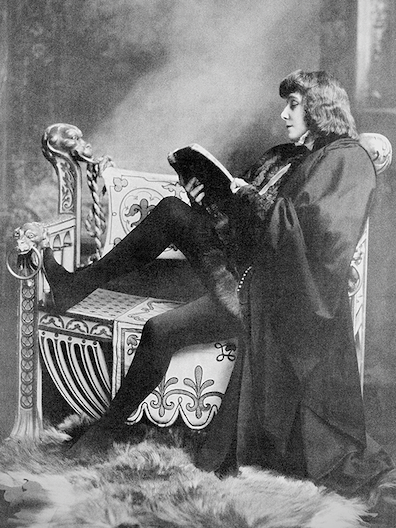§ "Hamlet
she played last night. Male impersonator":
Bloom thinks this of Millicent
Bandmann-Palmer, who did perform in the play at the Gaiety Theatre on June
15. Gifford notes that a review of the show in the next day's
Freeman's Journal mentioned that she acted the
principal role and "to say the least sustained it creditably."
Strange as it may seem today (perhaps—it is becoming common
again in the 21st century), such cross-gender casting was a
frequent practice in 1904. Just as theater companies in
Shakespeare's time cast boys in women's parts because women
were viewed as inferior creatures and legally barred from
London's stages, late 18th and 19th century theater companies
often cast women in men's parts because beloved female actors
could find relatively few substantial female roles in
Shakespeare's plays. The conversion of Shakespeare's men into
"breeches parts" or "pants roles" (terms also commonly used in
opera) had become increasingly frequent by the end of the 19th
century.
In an article titled "Tragedy, Gender, Performance: Women as
Tragic Heroes on the Nineteenth-Century Stage," Comparative
Literature 30.2 (1996): 135-57, Anne Russell ably
summarizes this history. Some of the performances she mentions
were so influential that for decades afterward women continued
to be cast in the same part: Sarah Siddons' Hamlet (1776-81),
Ellen Tree's Romeo (1832), Patricia Horton's Fool in King
Lear (1838). For theatrical producers of the time, the
Danish prince seemed particularly suited to female
interpretation, and "At least fifty English and American
actresses played Hamlet in the latter part of the nineteenth
century: Charlotte Cushman, Emma Walker, Fanny Wallack, Clara
Fisher Maeder, Alice Mariott, Julia Seaman, Winetta Montague,
and Millicent Bandmann-Palmer...who played Hamlet hundreds of
times" (143). The tradition reached a kind of apex in Sarah
Bernhardt's famous 1899 performances.
§ But "Perhaps
he was a woman": Bloom's focus shifts from seeing the
actress playing Hamlet as a male impersonator to wondering if
the character himself (or herself) somehow is (or was) a
woman. His source here is a 19th century American literary
critic named Edward Payson Vining whose thoughts about Hamlet
both reflected and influenced the female portrayals happening
on stage. In The Mystery of Hamlet; An Attempt to Solve an
Old Problem (1881), Vining argues that Queen Gertrude
gave birth to a girl. With war raging between Denmark and
Norway she dressed her child as a boy in hopes of ensuring her
offspring's succession to the throne. Vining devised this
backstory to explain Hamlet's feminine qualities: instead of
showing "the energy, the conscious strength, the readiness for
action that inhere in the perfect manly character" (46), the
prince spends his time deploring drunkenness, pondering
morality and religion, and emotionally leaping into graves.
This all seems pretty unlikely, as (leaving aside the gender
stereotypes) Shakespeare never alludes to any of Hamlet's
upbringing except his university education, and never in all his
soliloquies does the prince suggest that, in addition to
concealing a murderous intent behind an antic disposition, he is
also concealing a female nature behind a male appearance. In
Twelfth
Night, which he wrote at about the same time as
Hamlet,
Shakespeare got a lot of dramatic mileage out of a female
cross-dresser's self-disclosures to the audience, her public
embarrassments when male violence or heterosexual desire is
called for, and the sympathies she finds for both genders as a
result of her disguise. But Viola's trouser role as Cesario, and
Rosalind's as Ganymede, and Imogen's as Fidele—all of them men
playing women playing men—do arguably encourage a literary
critic to look around for further cases of gender-bending. In
that context, Vining's conceit of a woman dressing up as a man
to make her way in a male world does not seem so very fantastic.
Nor was his quasi-biographical way of reading a play all that
unusual for his time. Literary critics in the second half of the
19th century often studied leading characters in Shakespeare's
plays as if they might be real people, jumping off from mere
dialogue to sketch detailed psychological portraits and
inferring life histories that began well before the opening
scene. (The most famous work of this kind, A. C. Bradley's
Shakespearean
Tragedy, was published in the year in which
Ulysses
is set, 1904.) Such an approach feels dated now, but it was all
the rage in the Victorian and Edwardian era. It becomes truly
untenable only if one begins to think of Shakespeare's
characters as actual people. Bloom seems to flirt with this
absurdity by thinking that Hamlet "
was a woman," but he
maintains comic detachment in the following sentence: "
Why
Ophelia committed suicide."
Eglinton has his own wry detachment: "The bard's
fellowcountrymen," he supposes, "are rather tired perhaps of
our brilliancies of theorising. I hear that an actress
played Hamlet for the fourhundredandeighth time last night
in Dublin. Vining held that the prince was a woman. Has
no-one made him out to be an Irishman?" One Irishman whose
brilliancies of theorizing he is aiming at is Stephen, who has
been ransacking recent biographies of Shakespeare to construct
a pseudo-critical account of the playwright's life just as
fantastic as Vining's portrait of Hamlet. But seeing as how
Eglinton, Lyster, Best, and Mulligan are always throwing out
alternatives to Stephen's preferred authorities and
explanations, Joyce may be evoking the Hamlet-was-a-woman
theory here for a second reason. Vining's account of a
character ill-suited to a masculine world of violent action
sounds very much like the view of Hamlet advanced by Stephen's
argumentative opponents: "The beautiful ineffectual dreamer
who comes to grief against hard facts." Stephen's Hamlet is
much more the murderous man of action.


